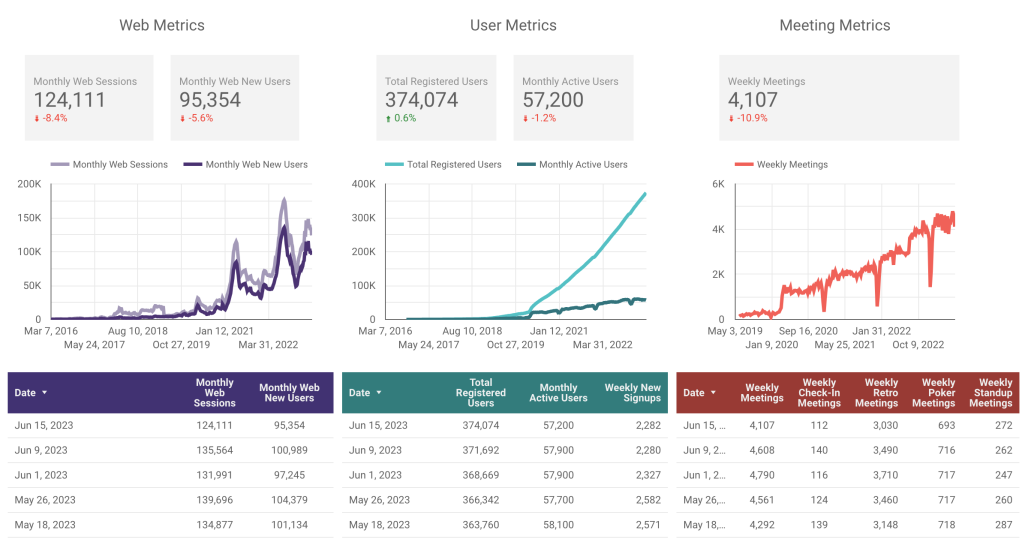#352 Mezzanine Professional Development
Friday Ship #352 | June 16th, 2023

This week, we saw our newest compensation policy in action: sub-leveling.
My two oldest sons have been practicing tae kwon do for several months now. Nothing has been more exciting that testing for the next belt. They have to put in many weeks of hard work to gain the skills to reach that next level. Their master has a lot of students to keep up with. How can he track their progress and know what they should focus on each class? The solution is smart, but simple. They use colored tapes for passing individual tests.
This tape system allows them to make progress in 4 areas between belts: (1) focus through learning forms, (2) confidence through breaking boards, (3) self-control through self-defense, and (4) mental development through learning Korean vocabulary for moves and commands. Each of these components is part of the final belt test. Earning tapes for passing ‘mini tests’ works like a charm. The master and his assistants can quickly see where students are at and help them work on the areas they lack in small groups.
We don’t do much kicking and punching around here at Parabol. But this illustration helps us think about one of the shortcomings to our framework for professional leveling. We’ve defined the belts, but haven’t had a tape system for tracking progress in between belts.
Leveling up at Parabol
We’ve worked hard over the last few years to define levels and compensation bands for different roles within the company. This gives us a better shared understanding of what it means to perform at a certain level within a role. This also helps us be objective and fair with compensation. However, this has raised new concerns about how to support folks better when they find themselves between levels. Here are some of challenges with our leveling process:
- It takes time to reach the next level. When somebody is making progress in between levels, how can we track this progress?
- It can be overwhelming to focus on many areas to reach the next level. Opportunities to focus on the areas needed don’t all come at once given that responsibilities come with time.
- Some skill dimensions fall within a role’s area of subject matter expertise. Other dimensions are common to everyone in the areas of collaboration, strategy, and people matters. How do we weigh these? Where should people give the most attention?
- Folks have to reach the next level to see an increase in pay. That jump can feel big. We haven’t had a way to provide small raises for incremental development and performance.
- Some folks naturally fall in between levels. For example, we may hire a senior developer who has been at that level for a few years. They probably have some substantial experience over a developer who is stepping into a senior role for the first time. How can we qualify this?
- The process to confirm one’s level has been high-effort and time-consuming. This requires employees to show how they’ve been performing from anywhere to 7 to 10 dimensions at once. The policy also requires that a panel of peers review all of this material and provide validation and feedback. This hurdle alone has made it daunting to level.
Introducing a sub-leveling policy
With these challenges in mind we’ve developed a sub-leveling policy to meet a few goals:
- Provide a way for members to focus on incremental professional development
- Provide a way for members to see objective, incremental raises in compensation for performance
- Provide an easier way to validate how a person has progressed
With the sub-leveling policy, there are few key differences from our process for fully leveling:
- Instead of having to review all dimensions to reach the next level at once, now folks can have a review for 1 or many dimensions at a time. These accomplishments add up as they advance toward the next level.
- Instead of a large gap in compensation at each level, we now have a way to incrementally increase compensation in between the bands of each level. As an example, if there’s a $30,000 difference between levels, and there are a total of 5 dimensions to qualify for the next level, folks could qualify for 1 dimension at a time for 1/5 of the difference, or $6,000.
- The skills are weighed more heavily toward subject matter expertise for individual contributors. For lead roles who have more accountabilities around people management and collaboration, those dimension have a bit more weight.
- This allows the review process to be lighter. Instead of having to gather evidence for all dimensions, and review all dimensions, now both the employee and the panel of peers can focus on fewer dimensions at a time.
Our biggest goal
Our biggest goal is that any policies around leveling and compensation serve the employees’ professional development as well as their sense of accomplishment and recognition. Within our culture, it’s important that everyone is involved in shaping how this framework works. Here’s what a few folks had to say:
I like that it makes the up-leveling process more “bite-sized”, and gives members an opportunity to confirm their level in certain skills before they’re ready to up-level fully, and benefit from added compensation that reflect those skills.
James Taber, Developer
The implementation of sub-leveling means I can receive insightful and honest feedback from my team around areas I can improve and be acknowledged and awarded on the areas I’m consistently strong in. I feel I have a clear path forward on how to take the next step.
Lili Caruso, Sales
We look forward to learning how this may improve our culture for professional development and fair and consistent compensation. We also realize it may bring new challenges.
- How might some dimensions be of greater impact than others?
- How might some skills be more difficult to obtain than others?
- Do we need to factor in a weight to these different dimensions and skills?
In the spirit of transparency, we share these learnings openly as we’re trying to get better at this. We realize nothing is perfect. How do you handle incremental professional development and raises at your organization?
Metrics

Many of the metrics took a dip this week. We may be seeing the start of users slowing down in the summer months.
This week we…
…shipped a Team Health feature! We’re introducing a first version of Team Health to learn from users exactly how we can develop this feature further. Folks can include this in their next Retro using the settings to start their meeting.

…shared insights on how we do product marketing. Lorena Martínez, Parabol Product Marketer, gave an interview talking about our marketing strategies.
…continued to ship enhancements to our Activity Library in beta. We’ve been learning about how this new way of discovering and starting meetings is working for our beta users. We’re shipping small enhancements in response to the most useful and critical feedback so far.
Next week we’ll
…wrap up trial projects with DevOps candidates. These are key hires as we develop how we serve up Parabol to our various tiers of customers, both on the cloud and in the public sector.
